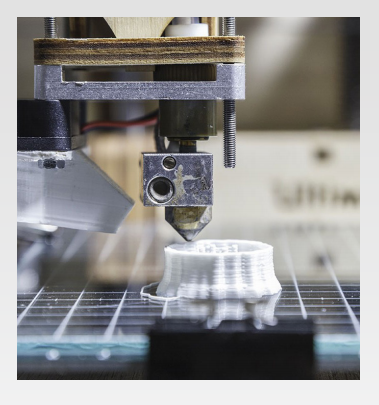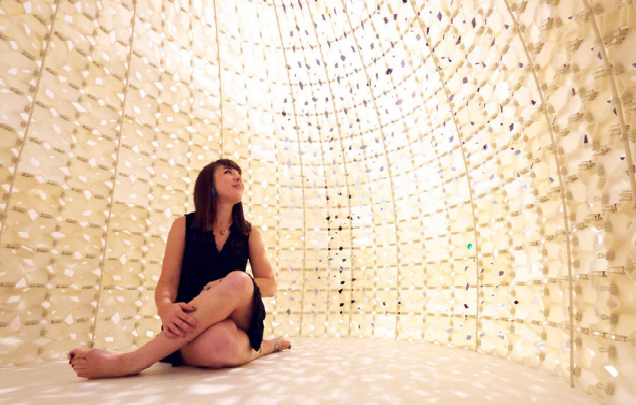“Go take your lessons from nature, that’s where our future lies.” – Leonardo da Vinci
 Virginia Commonwealth University student Mohammad Jawad takes a forward-looking approach to manufacturing, as 3D printing offers not only infinite potential for design and creation but also the possibility of ‘growing’ designed objects with biomaterials.
Virginia Commonwealth University student Mohammad Jawad takes a forward-looking approach to manufacturing, as 3D printing offers not only infinite potential for design and creation but also the possibility of ‘growing’ designed objects with biomaterials.
Jawad compares the natural world, where organisms grow in a pure manner, to that of the human environment where we create so much from artificial materials which are then put together in factories. Undeniably, manufacturing and mass production, along with the assembly press, have feathers in our caps for decades.
Mass production promotes sameness among objects, along with subtractive technology as parts are made from cutting or chipping away at materials until a product is shaped. While this may have been a novel idea at first, today our environment is saturated with chemicals and pollution, affecting both nature and man.
Jawad proposes that while the natural and man-made worlds may be extreme opposites, they should still be viewed as ‘a paradox of unity and duality,’ with an emphasis on how they complement one another. The author also sees 3D printing as a catalyst for bringing together nature and design mechanisms, ‘fusing’ them to the advantage of both the natural world and humanity.
The author is a fan of Neri Oxman, quoting her regarding the industrial revolution:
“Assembly lines have dictated a world made of standard parts framing the imagination of designers and builders who have been taught to think about their design objects and systems in terms of assemblies of parts with distinct functions. The assumption that parts are made of a single material and fulfill predetermined specific functions is deeply rooted in design and usually goes unquestioned; it is also enforced by the way that industrial supply chains work.”
Like nature, design is always evolving—via human creativity, inspiration, and ambition. In generative design, Jawad explains that nature is imitated with a variety of different digital parameters. Many users may be familiar with software like Python or Grasshopper, which can be adjusted to the complexity level of organic forms, along with connecting in real time to create structures related to natural stimuli like the sun or moisture in the air.
“The intricate forms, which are generated digitally, can only be fabricated using additive manufacturing, where objects are created by depositing material layer-by-layer,” says Jawad.
“Additive manufacturing resembles natural growth in the sense that it slowly builds an object, layer-by-layer. By integrating natural materials and processes with additive manufacturing, this thesis proposes a hybridized process for producing objects in a post-industrial world.”
Jawad highlights several art studios, ending with a glimpse into his own work:
- Emerging Objects, by Ronald Rael and Virginia San Fratello, is a 3D printing studio centered around making large-scale components and architectural structures. In his thesis, Jawad features ‘Saltygloo,’ a pairing of 3D printed materials with salt taken from San Francisco Bay.
- Erez Navi Pana created an exhibit called ‘Vegan Design,’ meant to support animal rights and the elimination of animal products. In his work, he experimented with vegan and natural materials; for example, one aspect of his exhibit shows off wooden stools he created and then placed in saltwater for several months until it was coated in crystallized salt.
- Markus Kayser exhibits ‘The Solar Sinter,’ which is a 3D printer using solar energy to melt sand into glass—involving a Fresnel lens that raises the temperature to 2900 degrees Fahrenheit.
- The Mediated Matter Group of MIT Media Lab has created ‘The Silk Pavilion,’ inspired by the silkworm’s cocoon. To create the exhibit even more realistically, the team fitted silkworms with sensors so they could study their movement while weaving.
- Gavin Munro has created ‘Zen 3D Printing,’ an organic process using the elements like an open-air factory, demonstrated in ‘Full Grown.’
As for his own work, Jawad states:
“My thesis research combined two key processes: natural crystallization, and 3D printing. This combination informed the conceptual framework, preliminary exploration and final outcomes. Together, I was able to pair nature’s own 3D generation technique—mineral crystallization—with the digital control of 3D printing, to develop new fabrication possibilities.”
Works like ‘Desert Rose’ are made of beautiful crystals from Qatar, along with numerous other stunning pieces where Jawad employs his generative methodology in combining 3D printing and natural crystals to make items that are useful.
“The possibility of hybridizing natural processes with digital fabrication provides a point of departure for fresh thinking, opening new possibilities for the future of design and production,” concludes Jawad.
3D printing offers potential in a variety of different industry dynamics, with some users on the side of being able to mass manufacture more affordably and efficiently, while others are encouraged by the idea of being able to produce on-demand parts and customized products—bringing an end to large warehouses and stress on the environment overall. Find out more about growing generatively designed products here.
What do you think of this news? Let us know your thoughts! Join the discussion of this and other 3D printing topics at 3DPrintBoard.com.
[Source / Images: ‘Manufactured by Nature: Growing Generatively Designed Products’]Subscribe to Our Email Newsletter
Stay up-to-date on all the latest news from the 3D printing industry and receive information and offers from third party vendors.
You May Also Like
Gorilla Sports GE’s First 3D Printed Titanium Cast
How do you help a gorilla with a broken arm? Sounds like the start of a bad joke a zookeeper might tell, but it’s an actual dilemma recently faced by...
Nylon 3D Printed Parts Made More Functional with Coatings & Colors
Parts 3D printed from polyamide (PA, Nylon) 12 using powder bed fusion (PBF) are a mainstay in the additive manufacturing (AM) industry. While post-finishing processes have improved the porosity of...
$25M to Back Sintavia’s Largest Expansion of Metal 3D Printing Capacity Since 2019
Sintavia, the digital manufacturing company specializing in mission-critical parts for strategic sectors, announced a $25 million investment to increase its production capacity, the largest expansion to its operations since 2019....
Velo3D Initiates Public Offering in a Bid to Strengthen Financial Foundations and Drive Future Growth
Velo3D (NYSE: VLD) has been among a number of publicly traded 3D printing firms that have attempted to weather the current macroeconomic climate. After posting a challenging financial report for 2023,...




































